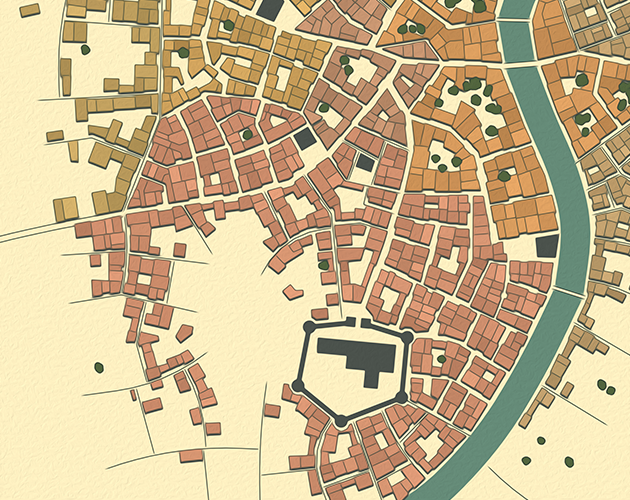I hear what you guys are saying and that sounds like it would certainly work at the hex-level, but will add this: when I did finally key the city at the street-level, and some of the abstraction disappeared, I found myself much more comfortable running city adventures. The place started to come alive and my players started spending more sessions solely in the city itself. They even started making plans that involved establishing themselves a home-base in some way.
Another big step forward was when I keyed the royal castle and church as multi-level dungeon, and worked out all the major NPCs and their motives etc. They even got "a little lost" in the castle's corridors at first.
There was a bit of push back, when I started asking things like
"which way do you go to get there?" etc. as they had an agenda and just wanted to see it implemented without worrying the details. But they are honestly always leaning that way...desiring to say "I do this" and have it magically happen unimpeded. As John Lennon famously said,
"Life is what happens to you while your making other plans." I think there some of that in D&D especially---the world frustrates PC desire. I think it keeps them motivated if you walk the line skillfully as a DM (and not too dogmatically).
I know a lot of folks can imagine getting bogged down in boring details about city-navigation, haggling with shopkeepers, etc. But there is something to be said for slowing down a bit and smelling the flowers. It forces the players to truly experience the location. Once something is known, of course, we move through it faster. But it's like that wonderful experience of being a tourist in a new city and piecing together it's layout. Likewise, the NPCs can become enemies, allies, and even friends the party is willing to "go to bat for".
It was very gratifying to finally make non-dungeon play click for us. It felt like a long-overdue accomplishment...something I never pulled off as a DM in my youth. Even as a player, with my great DM, we hand-waived a lot of that until it was an in-dungeon output. If you are interested in ever going the "city as dungeon" route, I suggest starting small and building your way up: a Keep (B2), a Village (T1), a Town, a (small) City, etc. De-scoping the scale of the world certainly helped me tackle the daunting task...as did allowing for there to be unfinished/unpainted elements only vaguely sketched in.
Otherwise the "city" is just a bunch of otherwise disconnected adventuring locations packed together.
I will be honest, I do rather lean this direction. Too much cohesion seems artificial at time. I also like my big dungeons to have some of this random naturalism. That said, what's a lot of fun for me is having various threads pop up repeated throughout the trapestry in a subtle manner. It forms connections that can be followed, but don't compel.
Cities also create the obligation for the DM to explain the contradictions inherent in DnD's frontier mechanisms running into a state apparatus strong enough to control a Polis. This is really difficult to portray effectively without a lot of attention to detail and world building.
Agreed. I do think you need to at least work out a legitimate explanation as to why the humans don't control everything in a region. Again, lower population helps. Middle Earth (in the books, forget the movies!) was a great example of a wilderness-heavy setting.

